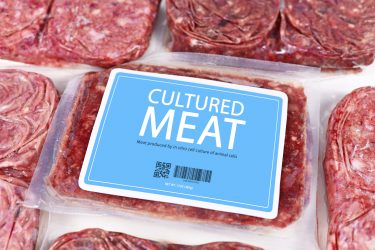How to stand the test of time in the cultured meat market
- Like
- Digg
- Del
- Tumblr
- VKontakte
- Buffer
- Love This
- Odnoklassniki
- Meneame
- Blogger
- Amazon
- Yahoo Mail
- Gmail
- AOL
- Newsvine
- HackerNews
- Evernote
- MySpace
- Mail.ru
- Viadeo
- Line
- Comments
- Yummly
- SMS
- Viber
- Telegram
- Subscribe
- Skype
- Facebook Messenger
- Kakao
- LiveJournal
- Yammer
- Edgar
- Fintel
- Mix
- Instapaper
- Copy Link
Posted: 3 November 2022 | Bethan Grylls (New Food) | No comments yet
As plant-based sales stagnate in the US, Bethan Grylls looks at the lessons that can be taken into the cultured meat industry, including how it should position and market itself around the world and what the best move is for those in plant proteins going forwards.


The year is 2030 and cultured meat has become the norm – this was the setting of MMR Research Worldwide’s Stardate event that took place in the Metaverse earlier this week. An apt location choice, as the expert line-up explored the future of food choices.
The idea that cultured meat will be widely available is not an unreasonable forecast, with the sector anticipated to be worth $572 million by 2027.1 Singapore and Israel led the way in 2020 with cultured chicken becoming commercially available in both countries. Eat Just was granted the world’s first regulatory approval to sell its chicken as an ingredient in Singapore, whilst Israeli-based SuperMeat now serves up lab grown chicken in its own restaurant.
The space is rapidly developing and the price gap between its traditional counterpart is closing. Since 2013, the cost has fallen from around $280,0000/kg to $10/kg today, with estimates suggesting this could fall further to $5.66/kg.1
Across the world, we’re seeing more and more cultured meat start-ups emerge and a rising level of investment from governments and the private sector. The driver: animal welfare and sustainability.
But what does this mean for plant-based meat alternatives, which are edging closer and closer to the ‘real deal’ in terms of taste and texture? Can there be room for both alternatives?
Plant-based meats: A curiosity trip?
While plant-based meat sales saw a record year in 2020, the category stagnated in 2021.2 Moreover, as MMR’s Chief Ideas Officer, Andrew Wardlaw, flagged during Stardate, although headlines around booming plant-based sales have been commonplace, the meat alternative segment has barely exceeded one percent of US meat sales.3,4
Last month plant-based leader, Beyond Meat, announced it would be making cuts to its workforce by 19 percent in attempt to achieve cash flow positive operations in the second half of 2023, following a fall in net revenues. The decrease in shares has been attributed by some to be a result of McDonald’s decision not to continue with the McPlant burger (made by Beyond Meat) in the States.5,6
A similar story has impacted Maple Leaf Foods, which acknowledged a “marked slowdown in plant-based protein category performance”. Its President and CEO, Michael McCain, said this could suggest “systemic change” in what was originally expected to be a high growth industry. As such, Maple Leaf Foods is looking to review its own investment in plant-based.


The MMR Metaverse
The uncertain future of plant-based meat was also raised in a report from the Good Food Institute: “It’s clear that despite the growth seen in the last decade, the success of the plant-based meat category is not inevitable.”
While Deloitte Insights said plant-based meats were getting “a reality check”, identifying the stagnation in the States as a result three things.
The first is that the addressable market wasn’t as large as first thought. Its research suggests that there is a “cultural resistance” to a product some view as “woke”, whilst others just aren’t interesting. Reason two is the result of inflation, with fewer people willing to pay a premium price. In fact, the willingness to pay more dropped by nine percent in the US from last year. Finally, consumers are becoming cynical and questioning the assumed benefits. The biggest change is in health perceptions; in 2021 as many as 68 percent of US consumers believed it was healthier than animal meat – this has fallen to 60 percent. A similar fall can be seen with positive environmental associations too.7
“Has this been a curiosity trip?” Wardlaw said, as he highlighted the results of an MMR survey which revealed many consumers are now questioning the ingredients and naturalness of these products.
“Could things fall flat as consumers rebel and reach for natural products?”
The more real, the less convinced
Interestingly, MMR survey of consumers in The Netherlands, US, UK, China and Singapore revealed that not only did the high price point and expansion of choice among plant-based meats put people off (one third in fact), but as the product performance improves, the perceived product integrity falls.
One US male respondent stated: “What goes into making it taste like meat? Because it’s actually pretty good.” According to Louise Hitchen, Head of Digital Qual at MMR, this reply perfectly captures the concerns most people have: how are plant-based meat manufacturers achieving such great results?
“We know people won’t compromise on sensory experience, but we can see unease as the product gets closer to the real thing,” she explained.
Dr Mark Hazelgrove, Behavioural Science Consultant at The Together Agency, said this reaction is not dissimilar to how we respond to extremely human-like robots. It’s a psychological response called the ‘uncanny valley’.
“As the non-meat entity becomes more meat-like, the uncanny valley kicks in,” he explained. “It’s a consequence of uncertainty.”
Dr Hazelgrove explained that as boundaries blur, people become apprehensive as they cannot define the category in which the mimic exists. It sits within this unknown area of “not quite meat but not quite non-meat either”.
Based on these opinions, Hitchen suggested the plant-based meat category shift away from meat, adding that with cultured meat on the horizon, it is the perfect opportunity to pivot.
In fact, according to the MMR study, 50 percent believe cultured meat will overtake plant-based. “That’s even before it’s widely available,” Hitchen pointed out.
Dr Hazelgrove agreed, but also said this was a lesson the cultured meat industry needed to heed too. “We need to move away from comparisons. This [ie, cultured meat] is not a comparison to meat, it is meat.”
He recommended that the industry establish a clear role of cultured meat within the meat category.
How to succeed in cultured meat
Reacting to market drivers
The results of the MMR survey showed that the main concerns among its respondents are climate change and mental health. But these head up an amalgamation of issues including future pandemics and food shortages.
Interestingly however, the results showed that the number one reason in the West for choosing vegan and vegetarian choices is animal welfare. Only in China is it sustainability.
It has been suggested that we can significantly reduce harmful climate impacts of traditional meat production through the cultivation of animal cells. Moreover, it is believed that such techniques could also lower the risk of zoonotic disease and antibiotic resistance, whilst slowing biodiversity loss and improving pollution levels.8
It appears most arguments for the rise of cultured meat focus predominantly on these aspects, but animal welfare does get some ‘airtime’. On the basis of MMR’s results, it is perhaps prudent to focus equally hard on the animal welfare aspect – at least for the US and UK markets. Saying this, the research did uncover that consumers already consider this new venture as a way to reduce animal suffering.
So with the drivers for plant-based the same for cultured meat, how can brands ensure this category doesn’t fizzle out?
Language on packaging is important
The MMR study unveiled some interesting insight into phrase preferences on cultured meat, with ‘100 percent cultured meat’ being well received as it implied nothing else had been added in. This ties in with the uncanny valley paradox noted earlier in the discussion – ie, the concern over a product intended to mimic and its content and integrity.
Surprisingly, the use of ‘slaughter-free” was also positively received, showing that there is benefit to expressing product perks more directly. Saying this, overall, people were less enthusiastic with phrases such as ‘pathogen-free’, ‘lab-grown’ and ‘animal cells’. The conclusion was that science-geared terms did not generally conjure up appetising images.

In terms of region, Brits favoured ‘cruelty-free’, with ‘slaughter-free’ not far behind; the US also preferred the use of ‘cruelty-free’ but this was superseded by ‘lean meat’. Whereas China’s results showed an equal split between ‘pathogen-free’, ‘100 percent traceable’ and ‘clean meat’.
When discussing her business, Future Meat Technologies’ CEO, Nicole Johnson-Hoffmann, said the term they preferred was “cultivated meat”, but noted that “great marketing is a conversation with consumers”.
She continued: “We’ll be working with consumers to understand the language, but our primary focus is to be transparent and direct, which often means simple and direct language.”
….But will cultured meat happen?
There is a mixed of curiosity and hesitancy when it comes to cultured meat, Hitchen said, referring to MMR’s research which found that 50 percent of those based in the US, 43 percent of Brits and 61 percent in China are willing to try it.
“Cultured meat is much easier to understand [than plant-based],” Hitchen continued. “It’s much closer to traditional meat and the impact on climate change is huge.”
But when presented with the scenario of a Friday night and you’re really fancying steak, farm reared still showed a significant hold on the consumer with 50 percent opting for it over cultured or plant-based.
An interesting comment from a respondent in the UK however, highlighted that the day could influence the menu. “I won’t risk Friday night, but I’ll happily serve it up on a Tuesday.” Does this mean that traditionally produced meat will become more of a luxury – regarded the same way as a takeaway pizza?
Johnson-Hoffmann, said she firmly believed cultured meat will become widely available but the first taste (not dissimilar to Singapore) will be in the restaurant. “That is a good way to ensure they [consumers] get a great sensory experience,” she explained.
With the event set in 2030, she was asked whether she felt it would be likely cultured meat would be commercially widespread across the globe by this point. The short answer: yes – and not just products but an entire ecosystem.
“By 2030 we should have a fully functional cultured meat supply chain,” she affirmed.
Indeed, cultured meat will soon be in restaurants and on shelves around the world, but to reach the same market share as meat will be a colossal triumph. This will require significant innovation, infrastructure and investment – and, of course, paying attention to what we have learnt from the plant-based market and what consumers really want.
It’s time to pay attention.
References
- fairr.org/article/cultured-meat-having-your-meat-and-eating-it-too/
- https://www.plantbasedfoods.org/insights-on-plant-based-meat-sales-in-2021/
- plantbasedfoods.org/2021-u-s-retail-sales-data-for-the-plant-based-foods-industry/
- https://www.forbes.com/sites/chloesorvino/2022/06/18/lifeless-market-for-meatless-meat/?sh=1ca90c978f24
- /www.cnbc.com/2022/07/28/beyond-meat-stock-falls-after-conclusion-of-mcdonalds-mcplant-test.html
- eatthis.com/news-mcdonalds-mcplant-test-over/
- deloitte.com/us/en/insights/industry/retail-distribution/future-of-fresh-food-sales/plant-based-meat-sales.html
- https://gfieurope.org/wp-content/uploads/2022/04/2021-Cultivated-Meat-State-of-the-Industry-Report.pdf
Related organisations
Beyond Meat, Deloitte Insights, Eat Just, Future Meat Technologies, Good Food Institute, Maple Leaf Foods, McDonald's, MMR Research Worldwide, SuperMeat, The Together Agency
Related regions
Related people
Andrew Wardlaw, Louise Hitchen, Mark Hazelgrove, Michael McCain, Nicole Johnson-Hoffmann




